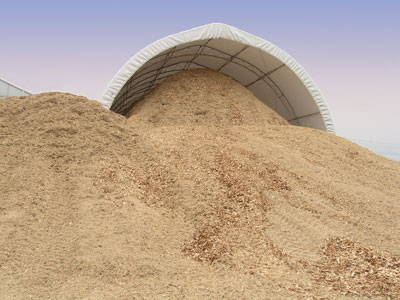
You will win the lenders over with a solid financial plan
The number one stumbling block for a Canadian bioenergy project is a lack of adequate financing.
 |
| One financial specialist recommends finding a secure 10-year wood fibre supply agreement. |
Previously, I’ve discussed the importance of a vision and a functioning team, but without adequate equity and capital investment, the dream could die. Credit strength questions are often left until the end of the project, with the hope that it will come together somehow. I’ve seen elaborate business plans without even a simple pro forma income and expense spreadsheet. Often there is no construction budget, cash flow timeline, or detailed breakdown of income sources. To launch a successful bioenergy project, you must start with a solid financial plan.
In the movie Cool Runnings, a Jamaican bobsleigh athlete asks his bank manager to sponsor his dream of competing in the winter Olympics. The bank manager cannot contain his disbelief and skepticism, and breaks into uncontrollable laughter. Fortunately, the movie is a comedy, but if you have been working in bioenergy for long, you know the feeling. We may like comedy, but we hate rejection, so we often procrastinate and avoid this difficult, yet vital, task.
MAKING YOUR BANKER A BELIEVER IN YOUR PROJECT
Bank managers are not the enemy; they are the guardians of our savings accounts and are paid to evaluate and minimize risk. So let’s look at what’s required to arrange financing for your project, rather than complaining about the bank’s lack of vision.
 |
| For a bioenergy project to be successful, you must focus on the need for financing during the early stages of business plan development. |
You may only get one chance to impress an investor or lender, and that person is faced with numerous projects vying for investment dollars. Which of those projects would you pick? The professional answer is: the one that has the least risk, the most available cash, and the best financial plan. You cannot walk in with no off-take market agreements and no money in your back pocket and expect someone to write a cheque based on your enthusiasm for the project. Think about why so many announcements are made and so few bioenergy projects are actually built.
A bank manager told project developers attending a recent bioenergy conference that “you need a secure 10-year wood fibre supply agreement, an off-take market agreement for five years at 80 per cent of production, proven cash flow, and 60 per cent equity.” He later told me that he was trying to chase away the “tire kickers.”
I have worked with this lender before and know that he would consider projects with lesser qualifications. However, your project needs to be prepared for that level of scrutiny. I can guarantee that a lot of prospective bioenergy groups went home discouraged that day; the lesson is that you need to be thoroughly prepared before you approach a potential investor or lender.
RAISING SUFFICIENT MONEY MAY BE YOUR BIGGEST CHALLENGE
For a bioenergy project to be successful, you must focus on the need for financing during the early stages of business plan development. Map out a strategy on how to raise sufficient money. This may be the most difficult part of the project.
There are several key components to creating a solid financial plan and attracting potential investors and lenders. Ask yourself the following five questions.
1. How much cash am I prepared to invest? The easy answer is, “the more, the better,” but realistically, a target of 25 per cent of the project costs is a good place to start. You may need to share the equity risk with other partners to get there, but it’s better to deal with this issue up front, rather than being told later you don’t have enough of your own capital in the project to qualify for financing. These days, getting 95 per cent project financing is near impossible. The more money you have available, the lower the perceived risk and the greater the chance of getting the project financed under attractive terms.
2. Do I have relevant business experience? If, for example, you have never made a biomass pellet or you have no wood harvesting experience, this issue needs to be addressed. The goal is to minimize risk and stand out in the crowd of bioenergy project developers. If your skill set is lacking, try to find a team member or committed business partner who can fill the experience gap. The people involved are very important, as it’s up to them to deliver on the business plan.
CONSIDER A JOINT VENTURE AS A FUNDING OPTION
3. Do I have a related company with strong credit that can offer support? This could make a huge difference in how the project is perceived, as it shows successful business experience and a willingness to put your proven expertise on the line. It is extremely difficult to arrange financing for a bioenergy project that does not want to have its parent company back it or its owners sign personal guarantees. If you are a start-up company with no parent company backing and limited cash resources, you should be prepared to look outside of traditional banking and consider joint ventures or other creative partnerships to access capital.
4. Do I have a financing advisor? Experienced project developers know it’s a good idea to pay for feasibility, engineering and market studies, and they also realize the value of financing advisors. A good broker/advisor searches for project funding from numerous sources and stays current with the latest financing developments. As a new industry, bioenergy financing can include numerous options, depending on credit strength, project size and company history. An experienced financing advisor can help you sort through the options and point you in the correct direction while minimizing time wasted.
5. Do I have a spreadsheet-based financial plan that can model different scenarios? With a computer-based spreadsheet, you can make quick and accurate changes to your financial plan based on any “what if” questions or changing feedstock and market conditions. One project I am advising on is on the ninth version of its financial plan, which remains accurate for today’s inputs and market conditions because it was built to model different scenarios quickly and easily. Your plan must be accurate to make it to the top of the investor’s list, and the ability to make quick changes based on market developments shows a high level of sophistication to a potential lender.
GOVERNMENT GRANTS ARE NOT EASY TO GET
I have not yet mentioned government funding, but that is not an oversight. Far too many project developers are chasing government grants in the hope of securing the additional funding needed to turn a project into reality. In truth, accessing government money is a time-consuming process and, if you qualify, the money often comes after the project is complete, not during the construction phase when it’s really needed. Grants can help, but they’re not the easy money many people believe they are.
You can be a start-up company with minimal cash, but you must have a thorough financial plan that includes income and expenses, cash flow projections, and a construction budget. It is also a good idea to work with a financing advisor who can get your plan to the right people.
Remember, if it were easy, everyone would be an Olympian. When discussing your financial plan, team and vision, keep in mind that potential investors and lenders are looking for shared risk and good credit strength. Start building your credit strength now.
Reg Renner of Atticus Financial in Vancouver finances equipment ranging from biomass boilers to greenhouse structures. He has 38 years of horticultural experience. • rrenner@atticusfinancial.com
Print this page